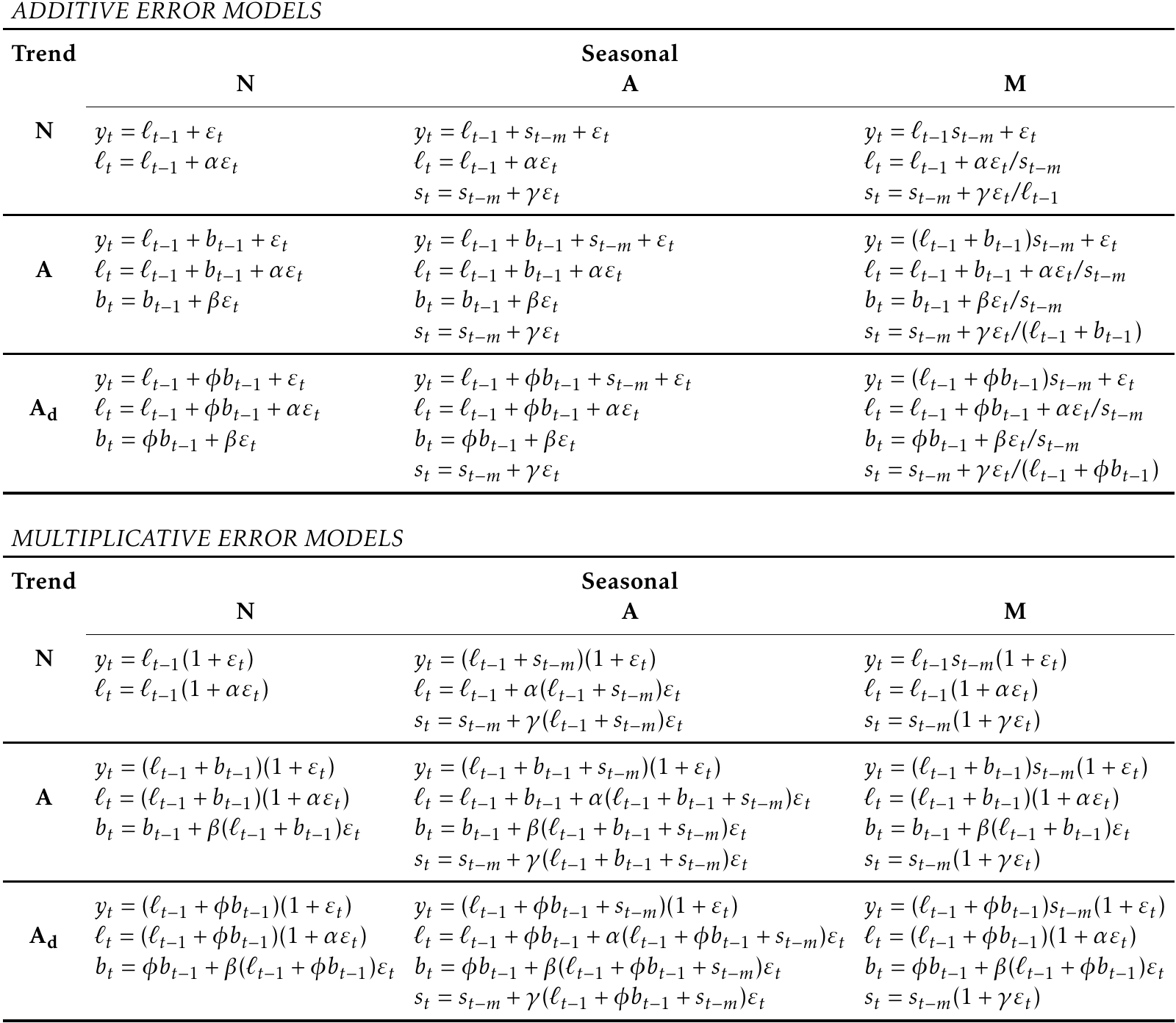Exponential smoothing
Exponential smoothing
- Simple model:
\[ \begin{align} \widehat{y}_{T+1|T} = & \alpha y_{T} + \alpha(1-\alpha) y_{T-1} \\ & + \alpha(1-\alpha)^{2} y_{T-2} + ... \end{align} \]
- Simple model with trend:
\[ \begin{align} \widehat{y}_{t+h|t} & = l_{t} + hb_{t} \\ l_{t} & = \alpha y_{t} + (1-\alpha)(l_{t-1} + b_{t-1}) \\ b_{t} & = \beta^{*} (l_{t} - l_{t-1}) + (1-\beta^{*})b_{t-1} \end{align} \]
- Now we’ll add seasonality.
Holt-Winters’ additive method
- Forecast equation:
\[ \widehat{y}_{t+h|t} = l_{t} + hb_{t} + s_{t+h-m(k+1)} \]
\[ \begin{align} l_{t} & = \alpha (y_{t} - s_{t-m}) + (1 - \alpha) (l_{t-1} + b_{t-1}) \\ b_{t} & = \beta^{*} (l_{t} - l_{t-1}) + (1 - \beta^{*}) b_{t-1} \\ s_{t} & = \gamma (y_{t} - l_{t-1} - b_{t-1}) + (1 - \gamma) s_{t-m} \end{align} \]
Holt-Winters’ multiplicative method
\[ \begin{align} \widehat{y}_{t+h|t} & = (l_{t} + h b_{t}) s_{t+h-m(k+1)} \\ l_{t} & = \alpha \frac{y_{t}}{s_{t-m}} + (1 - \alpha) (l_{t-1} + b_{t-1}) \\ b_{t} & = \beta^{*} (l_{t} - l_{t-1}) + (1 - \beta^{*})b_{t-1} \\ s_{t} & = \gamma \frac{y_{t}}{(l_{t-1} + b_{t-1})} + (1 - \gamma) s_{t-m} \end{align} \]
Example: Domestic overnight trips
- Let’s examine a data series with a clear seasonal component.
- Using the
tourismdataset, look at total holiday trips
# A tsibble: 24,320 x 5 [1Q]
# Key: Region, State, Purpose [304]
Quarter Region State Purpose Trips
<qtr> <chr> <chr> <chr> <dbl>
1 1998 Q1 Adelaide South Australia Business 135.
2 1998 Q2 Adelaide South Australia Business 110.
3 1998 Q3 Adelaide South Australia Business 166.
4 1998 Q4 Adelaide South Australia Business 127.
5 1999 Q1 Adelaide South Australia Business 137.
6 1999 Q2 Adelaide South Australia Business 200.
7 1999 Q3 Adelaide South Australia Business 169.
8 1999 Q4 Adelaide South Australia Business 134.
9 2000 Q1 Adelaide South Australia Business 154.
10 2000 Q2 Adelaide South Australia Business 169.
# ℹ 24,310 more rowsExample: Domestic overnight trips
- Let’s examine a data series with a clear seasonal component.
- Using the
tourismdataset, look at total holiday trips- So we’ll need to filter by
Purpose
- So we’ll need to filter by
# A tsibble: 6,080 x 5 [1Q]
# Key: Region, State, Purpose [76]
Quarter Region State Purpose Trips
<qtr> <chr> <chr> <chr> <dbl>
1 1998 Q1 Adelaide South Australia Holiday 224.
2 1998 Q2 Adelaide South Australia Holiday 130.
3 1998 Q3 Adelaide South Australia Holiday 156.
4 1998 Q4 Adelaide South Australia Holiday 182.
5 1999 Q1 Adelaide South Australia Holiday 185.
6 1999 Q2 Adelaide South Australia Holiday 135.
7 1999 Q3 Adelaide South Australia Holiday 136.
8 1999 Q4 Adelaide South Australia Holiday 169.
9 2000 Q1 Adelaide South Australia Holiday 184.
10 2000 Q2 Adelaide South Australia Holiday 134.
# ℹ 6,070 more rowsExample: Domestic overnight trips
- Let’s examine a data series with a clear seasonal component.
- Using the
tourismdataset, look at total holiday trips- So we’ll need to filter by
Purpose - And sum over all regions.
- So we’ll need to filter by
Example: Domestic overnight trips
- Let’s examine a data series with a clear seasonal component.
- Using the
tourismdataset, look at total holiday trips- So we’ll need to filter by
Purpose - And sum over all regions.
- Call the resulting dataset
aus_holidays
- So we’ll need to filter by
Example: Domestic overnight trips
- To apply the Holt-Winters method, use
model(ETS())as before- Specify the option
season("A")for additive season("M")for multiplicative
- Specify the option
Example: Domestic overnight trips
- Produce forecasts for the next three years and plot
Example: Domestic overnight trips

State space models
- Each of the models we’ve looked at has:
- A measurement equation that describes observed data
- State equation(s) that describe unobserved components
- Taken together, the models are called state space models
State space models
- Can be additive or multiplicative
- These are broadly referred to as ETS models (Error, Trend, Seasonal)
- Error = A, M
- Trend = N, A, \(A_{d}\)
- Seasonal = N, A, M
ETS(A,N,N)
- Recall:
We can re-express the smoothign equation as:
\[ \begin{align} \widehat{y}_{t+1|t} & = l_{t} \\ l_{t} & = \alpha y_{t} + (1 - \alpha) l_{t-1} \end{align} \]
\[ \begin{align} l_{t} & = l_{t-1} + \alpha (y_{t} - l_{t-1}) \\ & = l_{t-1} + \alpha e_{t} \end{align} \]
ETS(A,N,N)
- To finally specify our state space model, we have to make an assumption about the probability distribution of the residuals \(e_{t}\).
- With additive errors, residuals are usually assumed \(\epsilon_{t} \sim N(0,\sigma ^{2})\).
- Then we can write our model:
\[ \begin{align} \textrm{Measurement equation: } y_{t} & = l_{t-1} + \epsilon_{t} \\ \textrm{State equation: } l_{t} & = l_{t-1} + \alpha \epsilon_{t} \end{align} \]
A taxonomy of ETS models

Figure: Measurement and state equations for various ETS models